How to Get Rid of Purple Stains on My Pillow? Natural Solutions to the Problem
Waking up to find your pillow adorned with unsightly purple stains can be frustrating and disheartening. If you’ve ever wondered how to get rid of purple stains on my pillow, you’re not alone. Many of us struggle with this issue, and while I’ve tried a few methods that yielded mixed results, there’s still much to explore.
From effective DIY solutions to promising commercial products, the options can feel overwhelming. If you’re also dealing with this problem, the tips and tricks I’m about to share might just be the answer you’ve been searching for to banish those pesky stains for good and prevent them from returning.
How to Get Rid of Purple Stains on My Pillow
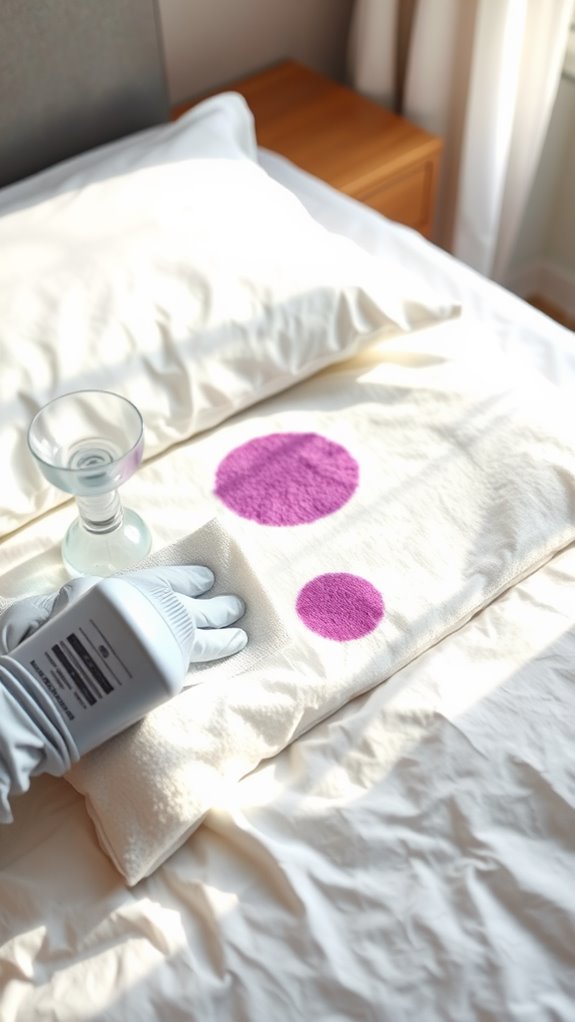
Dealing with purple stains on my pillow can be frustrating, but I’ve found some effective methods to tackle them.
First off, I wash my pillowcases weekly in cold water with a gentle detergent. This not only keeps stubborn stains at bay but also helps maintain hygiene by preventing the buildup of sweat and skincare product residues.
When those pesky stains do appear, I whip up a DIY cleaning solution with baking soda and castile soap, applying it directly to the stain.
After washing, I like to let my pillows bask in sunlight exposure for a few hours—nature’s very own whitening treatment! Additionally, I ensure that I wash whites separately to prevent any color transfer that might lead to further staining.
If all else fails, I don’t hesitate to grab specialized stain removers or even replace the pillow to keep my sleep sanctuary fresh.
Method 1: Using Baking Soda and Vinegar
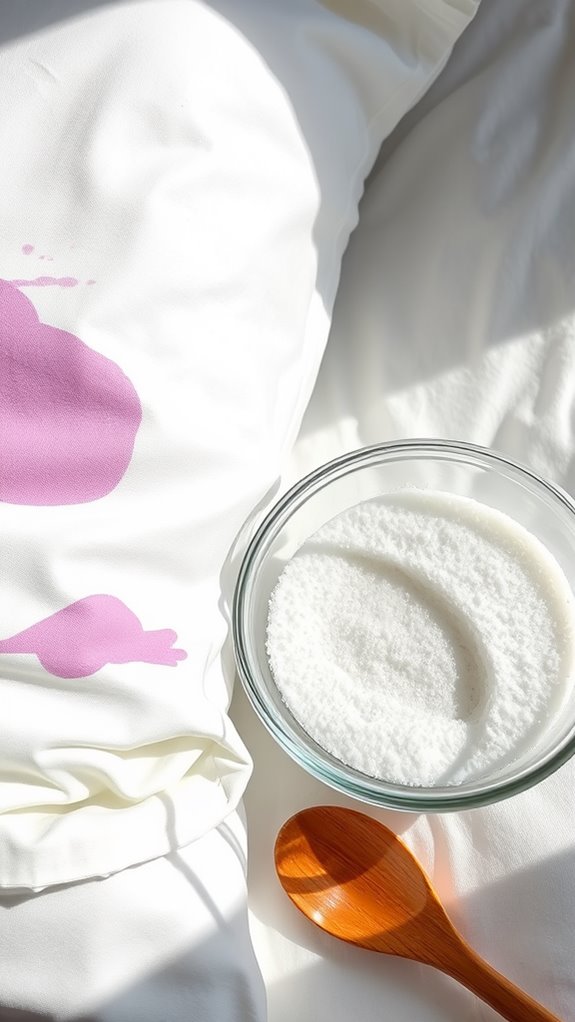
One effective method I’ve found for tackling purple stains on pillows is using baking soda and vinegar. This dynamic duo works wonders!
Here’s how I tackle those pesky stains:
- Sprinkle a generous amount of baking soda over the stained area.
- Spray a mixture of equal parts vinegar and warm water onto the baking soda.
- Let it bubble and fizz for 15-30 minutes to disinfect the fabric.
- Blot with a clean cloth, then wash the pillowcase in cold water with gentle detergent.
After washing, I like to give my pillow a little sunlight bath. Not only does it help naturally bleach the stains, but it also leaves my pillows smelling fresh and clean! Regular washing of bedding is essential for maintaining health and hygiene, so don’t forget to incorporate this into your cleaning routine.
Trust me, your pillows will thank you!
Method 2: Applying Hydrogen Peroxide
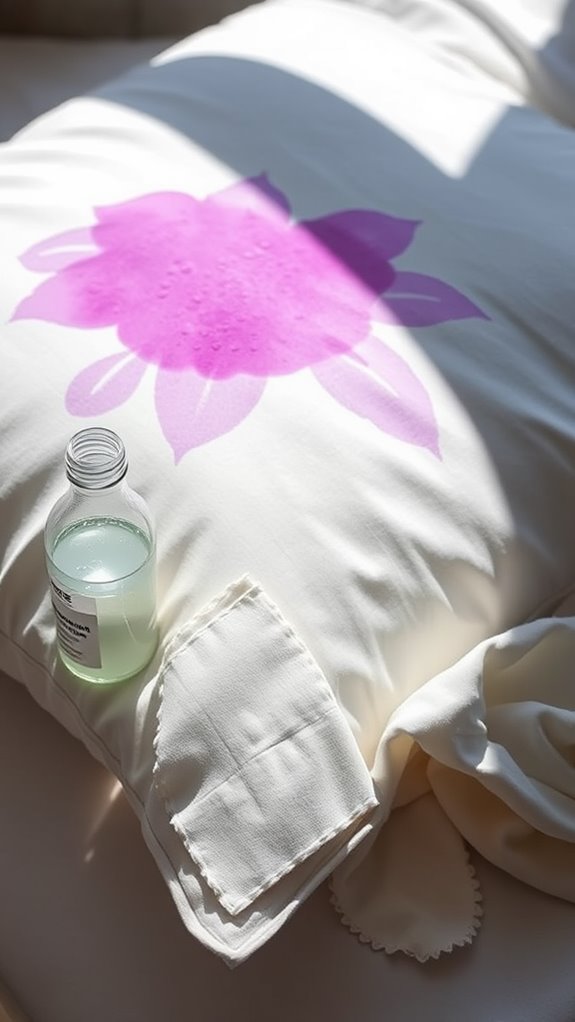
Hydrogen peroxide is a powerful ally when it comes to removing stubborn purple stains from pillows.
Imagine this: your favorite pillow, marred by unsightly organic stains from skincare or late-night snack attacks. Fear not! Grab a 3% solution of hydrogen peroxide, and apply it directly to the stains. Let it sit for about 30 minutes, allowing it to work its magic.
Just in case your pillow’s a bit sensitive, I’d recommend testing it on a hidden spot first to avoid any unexpected discoloration.
For those particularly stubborn stains, mix hydrogen peroxide with baking soda to create a thick paste for extra cleaning power.
Once you’ve tackled those stains, simply rinse and wash your pillow following the care instructions. Fresh pillow, here I come!
Method 3: Commercial Stain Removers
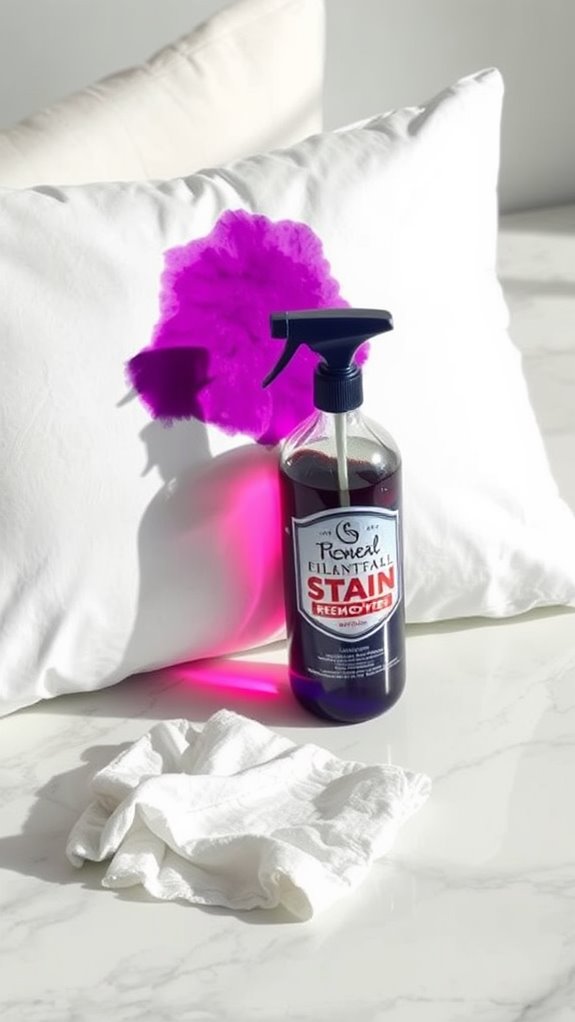
Sometimes, tackling stubborn purple stains requires a little extra assistance from commercial stain removers.
These powerful allies are a game-changer, especially for protein-based stains caused by sweat.
Here’s what I’ve learned:
- Look for stain removers packed with enzymes to break down those pesky organic stains.
- Always do a patch test on a hidden spot of your pillowcase—trust me, you don’t want an unexpected discoloration party.
- Follow the application instructions carefully; every product has its quirks.
- Consider oxygen bleach-based options—safe for most fabrics and they brighten up stained pillows like magic!
With these tips, your pillow can go from purple disaster to pristine perfection, making bedtime a little less dramatic and a lot more dreamy!
Common Causes of Purple Stains on Pillows
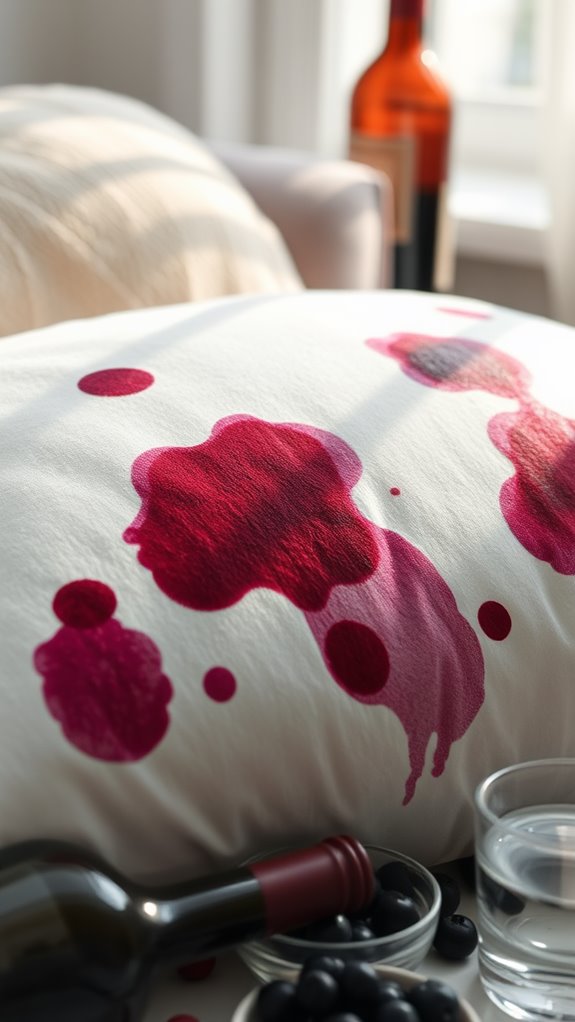
After exploring commercial stain removers, it’s important to understand what causes those pesky purple stains on pillows in the first place.
Envision this: your cotton pillowcase, innocent and pure, meets saliva that’s been feasting on seafood. Yep, iodine from your mouth can react with the starch in cotton, creating those annoying purple stains.
But wait, there’s more! Hair products, body oils, and skin care residues can throw a wild party on your pillow, contributing to the mess.
And let’s not forget about poor pillow hygiene—if you’re washing infrequently, moisture-related factors like sweat and drool just add to the chaos.
Preventing Future Purple Stains on Your Pillow
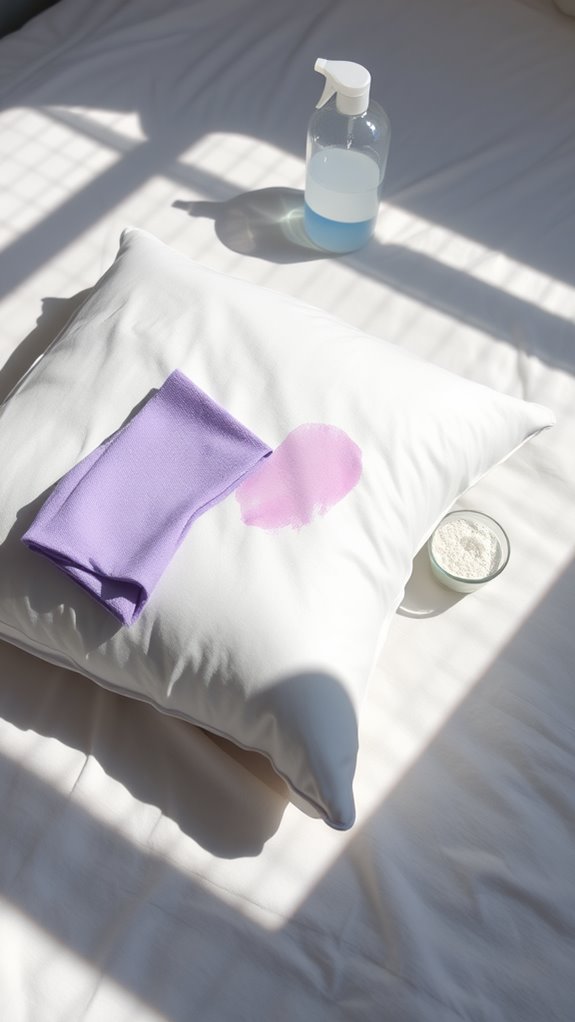
Preventing those pesky purple stains on your pillow starts with a few simple adjustments.
I’ve found that switching to silk pillowcases works wonders since they don’t react with iodine in saliva. It’s like giving your pillow a VIP treatment!
Here are some tips to keep your pillow pristine:
- Regularly wash your pillowcases in cold water to kick those staining agents to the curb.
- Cut back on hair products that contain dyes or oils—your pillow doesn’t need a makeover!
- Stick to a skincare routine that avoids iodine-rich products, especially if you notice any discoloration.
- Stay hydrated and maintain good oral hygiene; a healthier mouth means less staining.
- Additionally, consider washing your pillows every 2-3 months to keep them clean and free from bacteria that can contribute to discoloration.
With these tweaks, I’m sure you’ll keep those purple stains at bay!
Additional Tips for Maintaining Pillow Cleanliness
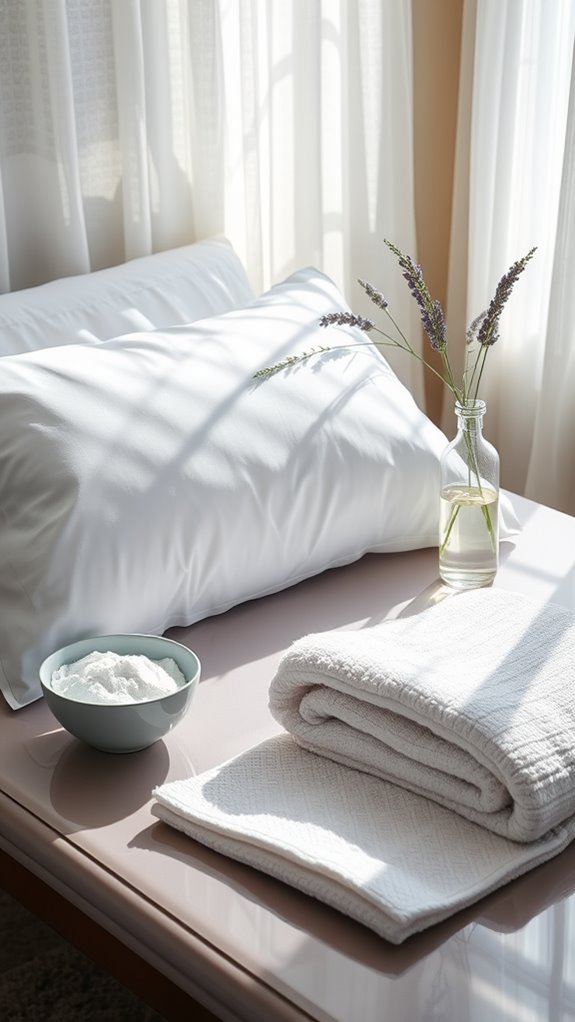
While maintaining pillow cleanliness might seem like a chore, it’s essential for a good night’s sleep and overall health. Trust me, washing pillowcases weekly in cold water is a game changer. It keeps bacteria, oils, and those sneaky staining agents at bay.
I like to regularly air out my pillows in sunlight, letting nature do its magic to banish moisture and mold. Fluffing pillows daily? It’s like a mini workout—keeping them comfy and evenly distributing any moisture.
Don’t forget those protective pillow covers; they’re like superheroes against sweat and drool! Finally, keep an eye out for signs of wear; older pillows can become breeding grounds for allergens and discoloration. Washing new pillows can also help eliminate dust mites that thrive on dead skin cells, ensuring a healthier sleep environment.
Keeping stains away makes for a happier, healthier sleep!
Frequently Asked Questions
How Do You Clean a Purple Pillow?
To clean my purple pillow, I remove the grid, wash it gently in warm water, and clean the cover in cold. I tumble dry on low and air dry the grid to keep its shape.
What Causes Purple Stains?
I’ve noticed purple stains can come from iodine in saliva reacting with cotton. Diet, medications, or even hair products might contribute too. Regularly washing pillowcases helps prevent these pesky discolorations from forming in the first place.
Why Do I Wake up With Stains on My Pillow?
I often wake up with stains on my pillow due to saliva mixing with food residues or skincare products. It’s frustrating, but I’ve found that improving my oral hygiene and washing my pillowcases helps.
How to Get Blood Stains off of a Pillow?
To remove blood stains from my pillow, I rinse the area with cold water, apply a baking soda paste, and let it sit. If needed, I use hydrogen peroxide before washing it in cold water.
In Conclusion
In dealing with purple stains, you have effective solutions at your disposal! A mixture of baking soda and vinegar can help lift those marks, while hydrogen peroxide is another useful option.
Preventive measures are equally important—regularly washing your pillows and checking for stains can help you avoid future discoloration. Take action now to restore your pillows and enjoy restful nights with clean, fresh bedding!
